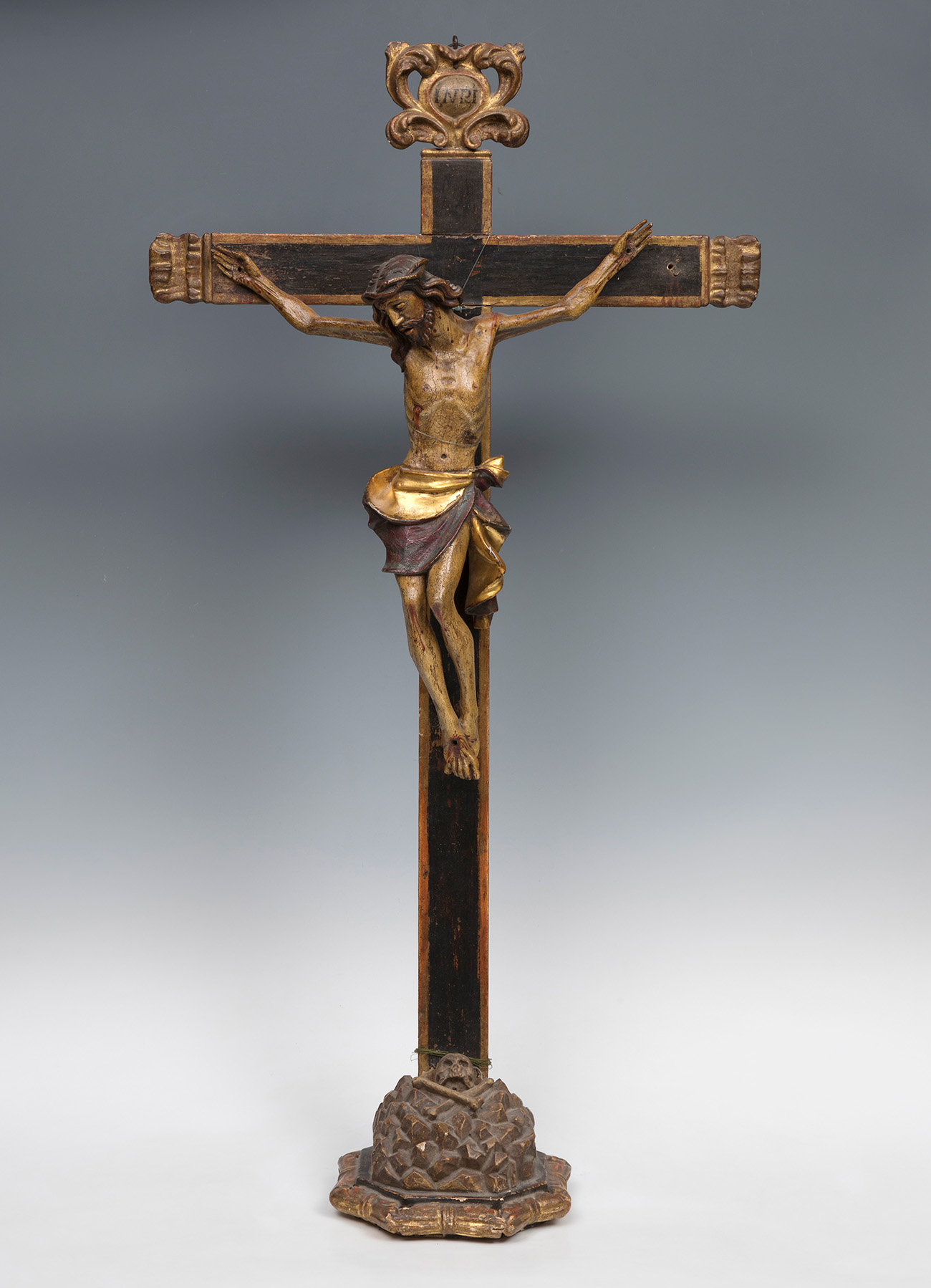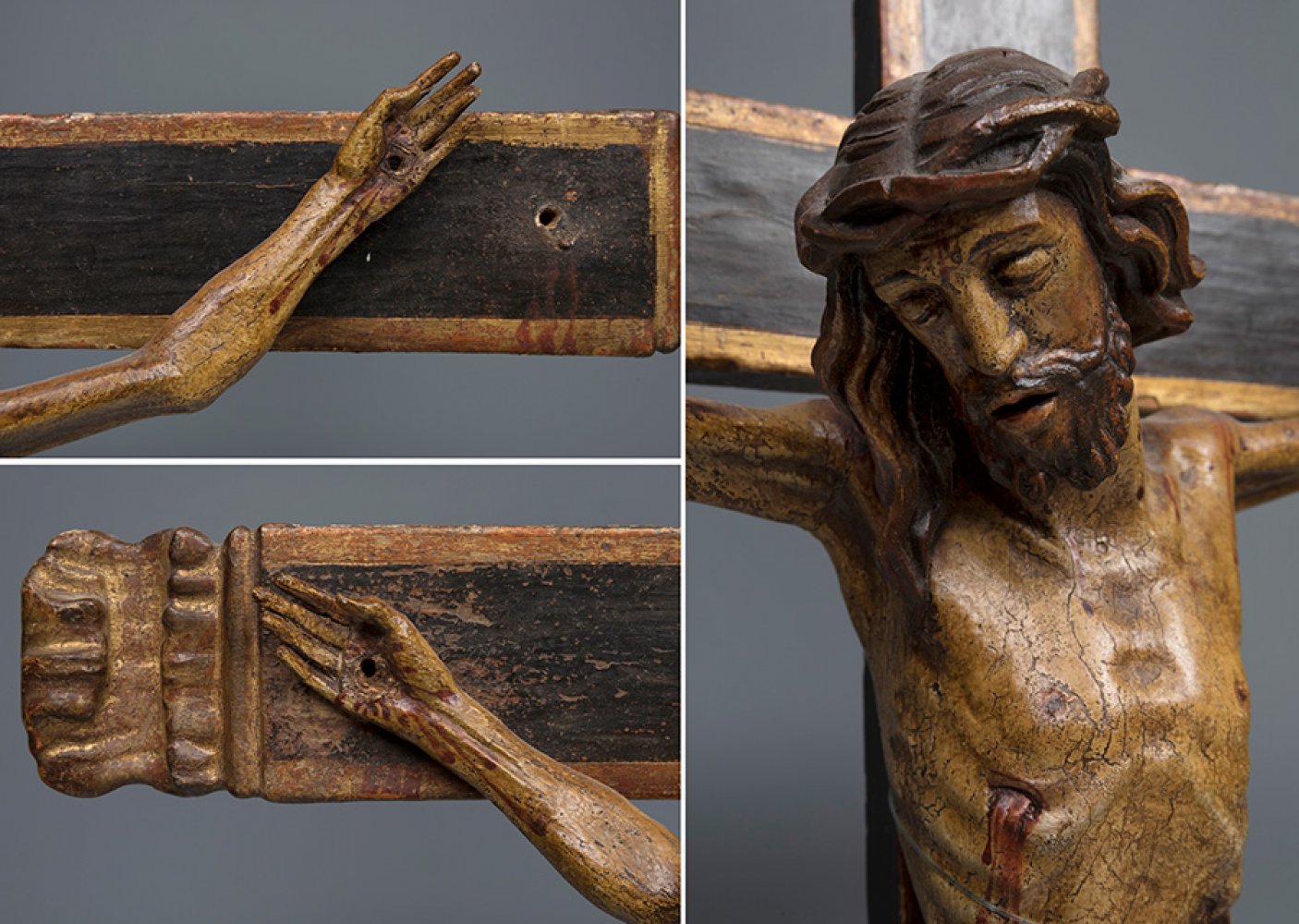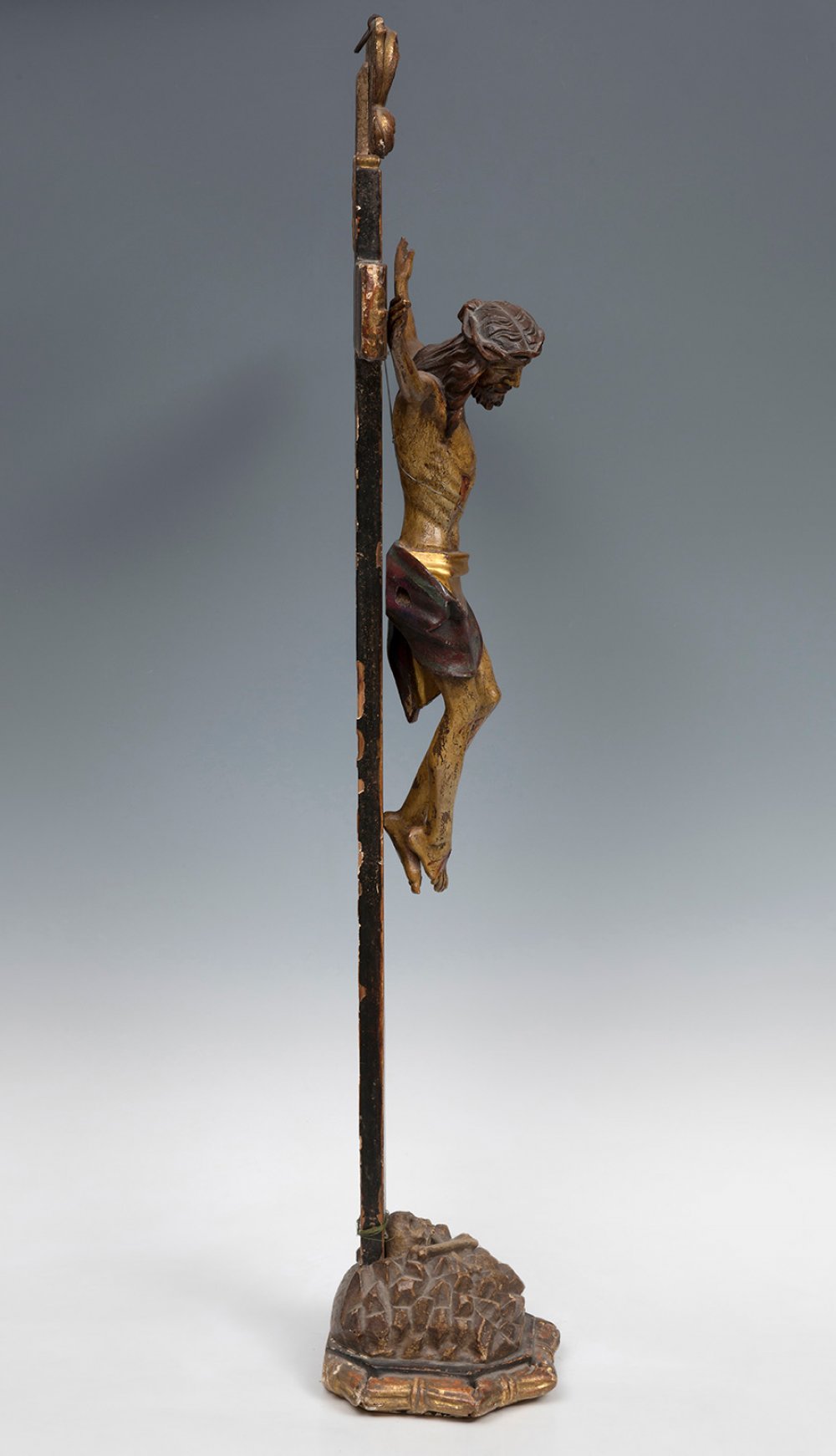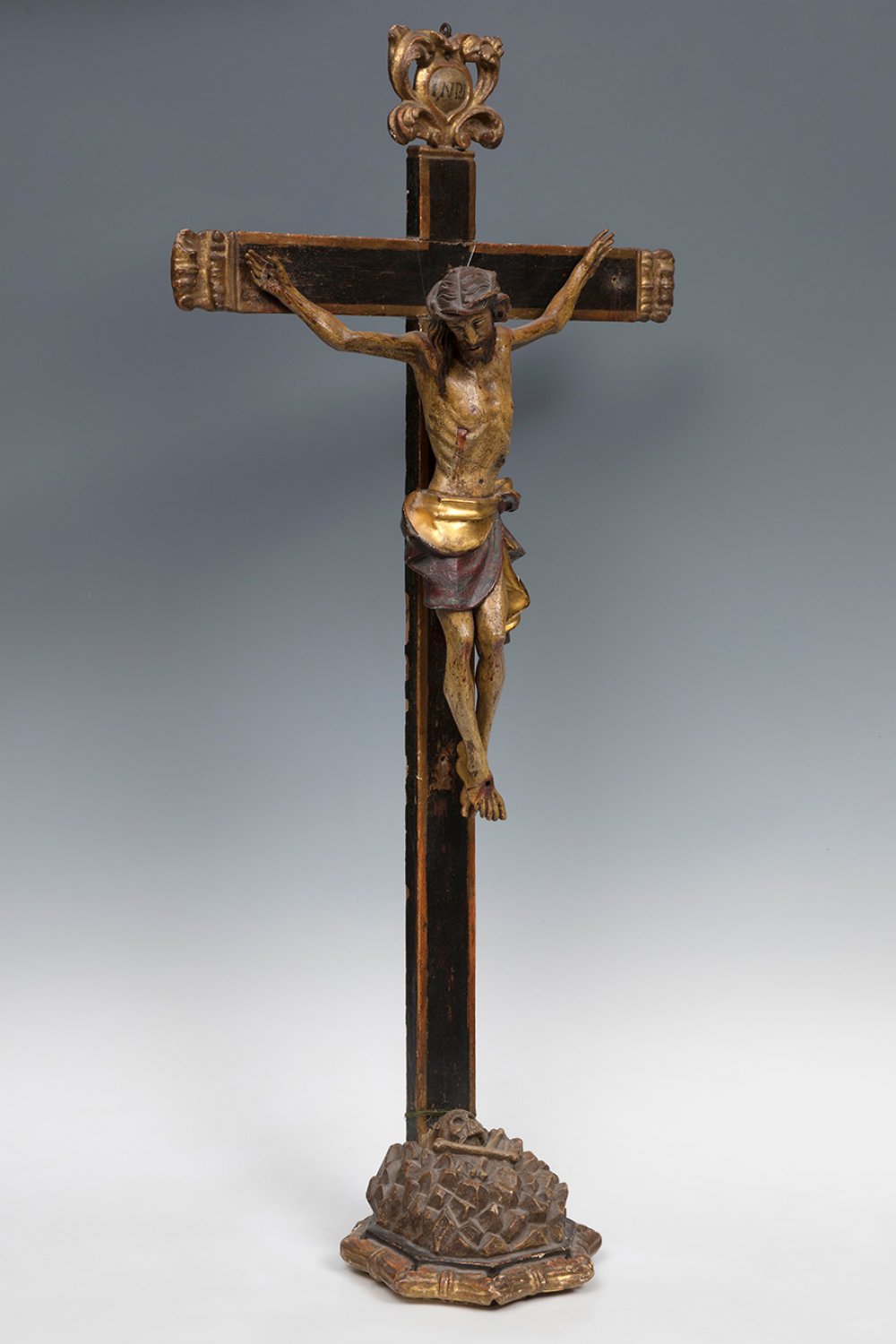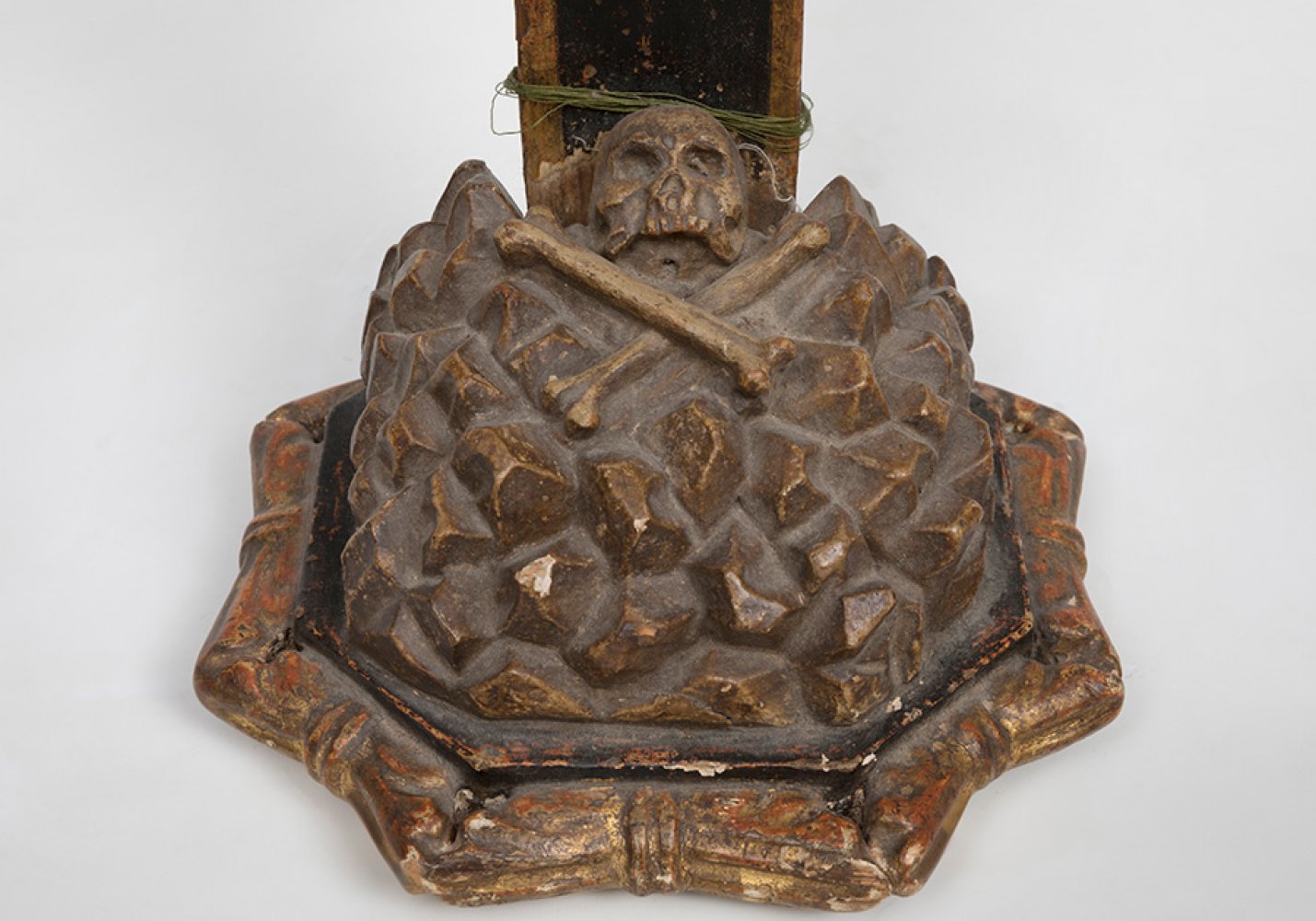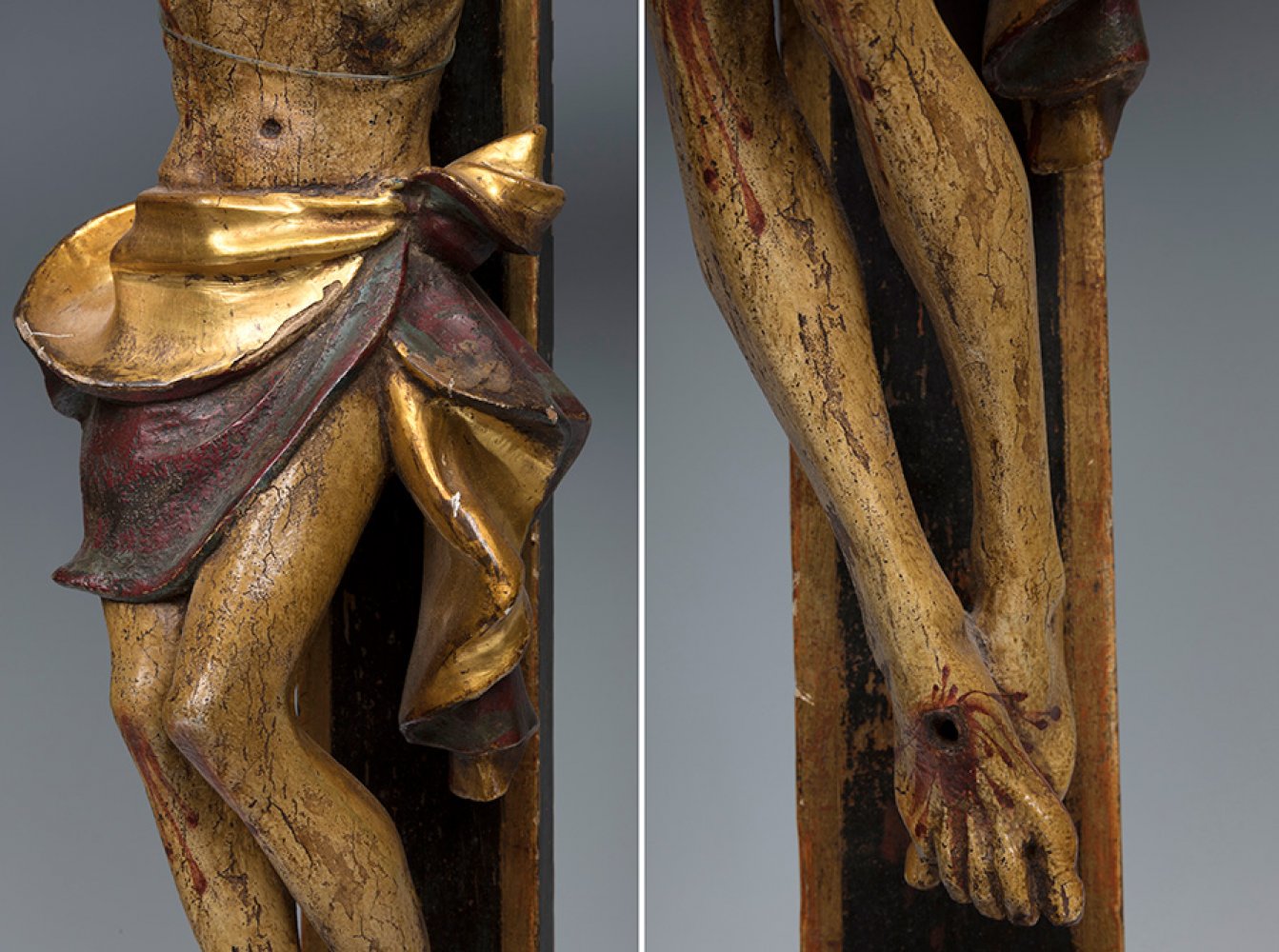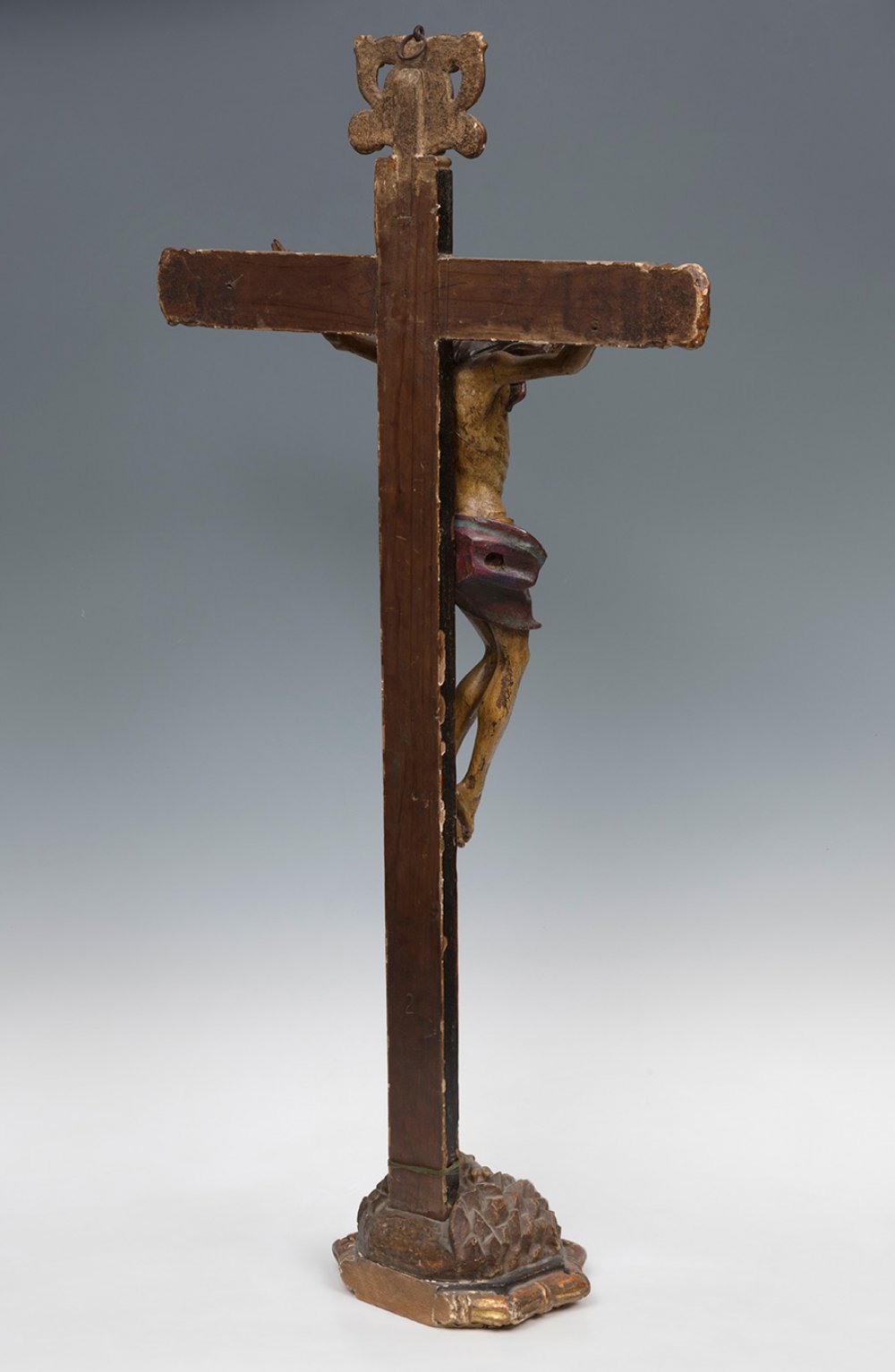50
Spanish school of the 18th century."Crucified Christ".Carved and polychrome wood.It presents
1/7
Description
Spanish school of the 18th century.
"Crucified Christ".
Carved and polychrome wood.
It presents faults (detached from the Cross).
Measurements: 102 x 55 x 19 cm.
Round sculpture representing the body of Christ at the moment of the Crucifixion, anchored to the Cross and on Adam's skull. It is a very stylised Christ, anatomically speaking, wearing only the crown of thorns and the cloth of purity. The volume and dynamism that the artist has achieved in its execution, as well as the subtle gilding that outlines the cross and decorates the cloth of purity, stand out enormously.
Crucifixions and crucifixes have appeared in the history of art and popular culture since before the era of the pagan Roman Empire. The crucifixion of Jesus has been depicted in religious art since the 4th century. It is one of the most recurrent themes in Christian art and the one with the most obvious iconography. Although Christ is sometimes depicted clothed, his body is usually depicted naked, although with his genitals covered with a purity cloth (perizonium); full nudes are very rare, but prominent (Brunelleschi, Michelangelo, Cellini). The conventions of depicting the different attitudes of the crucified Christ are designated by the Latin expressions Christus triumphans ("triumphant" - not to be confused with the Maiestas Domini or the Pantocrator), Christus patiens ("resigned" - not to be confused with the Christ of patience) and Christus dolens ("suffering" - not to be confused with the Vir dolorum). The triumphans is represented alive, with his eyes open and his body erect; the patiens is represented dead, with his will totally emptied (kenosis), his head bowed, his face with a serene expression, his eyes closed and his body arched, showing the five wounds; the dolens is represented in a similar way to the patiens, but with a gesture of pain, particularly in his mouth (curved).
"Crucified Christ".
Carved and polychrome wood.
It presents faults (detached from the Cross).
Measurements: 102 x 55 x 19 cm.
Round sculpture representing the body of Christ at the moment of the Crucifixion, anchored to the Cross and on Adam's skull. It is a very stylised Christ, anatomically speaking, wearing only the crown of thorns and the cloth of purity. The volume and dynamism that the artist has achieved in its execution, as well as the subtle gilding that outlines the cross and decorates the cloth of purity, stand out enormously.
Crucifixions and crucifixes have appeared in the history of art and popular culture since before the era of the pagan Roman Empire. The crucifixion of Jesus has been depicted in religious art since the 4th century. It is one of the most recurrent themes in Christian art and the one with the most obvious iconography. Although Christ is sometimes depicted clothed, his body is usually depicted naked, although with his genitals covered with a purity cloth (perizonium); full nudes are very rare, but prominent (Brunelleschi, Michelangelo, Cellini). The conventions of depicting the different attitudes of the crucified Christ are designated by the Latin expressions Christus triumphans ("triumphant" - not to be confused with the Maiestas Domini or the Pantocrator), Christus patiens ("resigned" - not to be confused with the Christ of patience) and Christus dolens ("suffering" - not to be confused with the Vir dolorum). The triumphans is represented alive, with his eyes open and his body erect; the patiens is represented dead, with his will totally emptied (kenosis), his head bowed, his face with a serene expression, his eyes closed and his body arched, showing the five wounds; the dolens is represented in a similar way to the patiens, but with a gesture of pain, particularly in his mouth (curved).
Auction Details
Shipping
T&Cs & Important Info
Ask seller a question
Spanish school of the 18th century.
"Crucified Christ".
Carved and polychrome wood.
It presents faults (detached from the Cross).
Measurements: 102 x 55 x 19 cm.
Round sculpture representing the body of Christ at the moment of the Crucifixion, anchored to the Cross and on Adam's skull. It is a very stylised Christ, anatomically speaking, wearing only the crown of thorns and the cloth of purity. The volume and dynamism that the artist has achieved in its execution, as well as the subtle gilding that outlines the cross and decorates the cloth of purity, stand out enormously.
Crucifixions and crucifixes have appeared in the history of art and popular culture since before the era of the pagan Roman Empire. The crucifixion of Jesus has been depicted in religious art since the 4th century. It is one of the most recurrent themes in Christian art and the one with the most obvious iconography. Although Christ is sometimes depicted clothed, his body is usually depicted naked, although with his genitals covered with a purity cloth (perizonium); full nudes are very rare, but prominent (Brunelleschi, Michelangelo, Cellini). The conventions of depicting the different attitudes of the crucified Christ are designated by the Latin expressions Christus triumphans ("triumphant" - not to be confused with the Maiestas Domini or the Pantocrator), Christus patiens ("resigned" - not to be confused with the Christ of patience) and Christus dolens ("suffering" - not to be confused with the Vir dolorum). The triumphans is represented alive, with his eyes open and his body erect; the patiens is represented dead, with his will totally emptied (kenosis), his head bowed, his face with a serene expression, his eyes closed and his body arched, showing the five wounds; the dolens is represented in a similar way to the patiens, but with a gesture of pain, particularly in his mouth (curved).
"Crucified Christ".
Carved and polychrome wood.
It presents faults (detached from the Cross).
Measurements: 102 x 55 x 19 cm.
Round sculpture representing the body of Christ at the moment of the Crucifixion, anchored to the Cross and on Adam's skull. It is a very stylised Christ, anatomically speaking, wearing only the crown of thorns and the cloth of purity. The volume and dynamism that the artist has achieved in its execution, as well as the subtle gilding that outlines the cross and decorates the cloth of purity, stand out enormously.
Crucifixions and crucifixes have appeared in the history of art and popular culture since before the era of the pagan Roman Empire. The crucifixion of Jesus has been depicted in religious art since the 4th century. It is one of the most recurrent themes in Christian art and the one with the most obvious iconography. Although Christ is sometimes depicted clothed, his body is usually depicted naked, although with his genitals covered with a purity cloth (perizonium); full nudes are very rare, but prominent (Brunelleschi, Michelangelo, Cellini). The conventions of depicting the different attitudes of the crucified Christ are designated by the Latin expressions Christus triumphans ("triumphant" - not to be confused with the Maiestas Domini or the Pantocrator), Christus patiens ("resigned" - not to be confused with the Christ of patience) and Christus dolens ("suffering" - not to be confused with the Vir dolorum). The triumphans is represented alive, with his eyes open and his body erect; the patiens is represented dead, with his will totally emptied (kenosis), his head bowed, his face with a serene expression, his eyes closed and his body arched, showing the five wounds; the dolens is represented in a similar way to the patiens, but with a gesture of pain, particularly in his mouth (curved).
29th December - Old Masters
Sale Date(s)
Venue Address
Aragón 346, Barcelona
Calle Velázquez 7, Madrid
Carrer de Cirilo Amorós 55, Valencia
Barcelona
08009
Spain
General delivery information available from the auctioneer
Setdart offers Worldwide shipping
PICK UP IN ROOM: You can come and pick up your lots in our offices (Barcelona, Madrid or Valencia). At the moment of the withdrawal, you will be able to accept the current conditions of the lot by means of a document that you will sign.
YOU CAN SEND ANOTHER PERSON TO PICK UP: This person must present a signed authorization that you can find in our web page by accessing from BUY AT SETDART- LOGISTICS-DOWNLOAD AUTHORIZATION DOCUMENT. You can also send an e-mail with the requested data in AUTHORIZATION DOCUMENT to admin@setdart.com
Important Information
25% buyer´s premium
21% buyer´s premium at www.setdart.com















